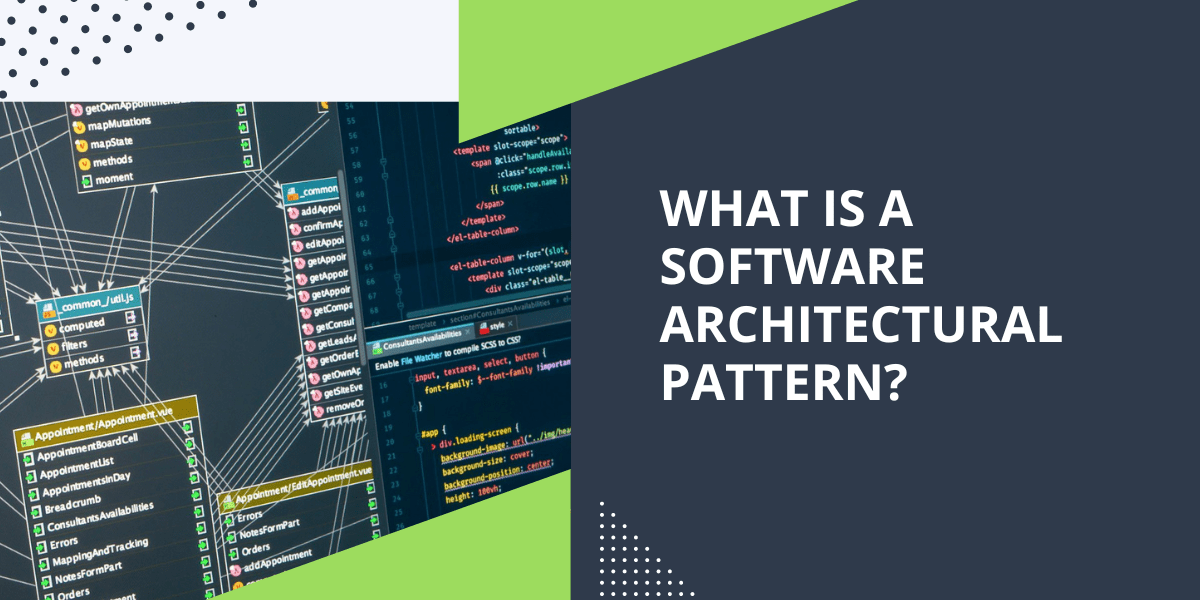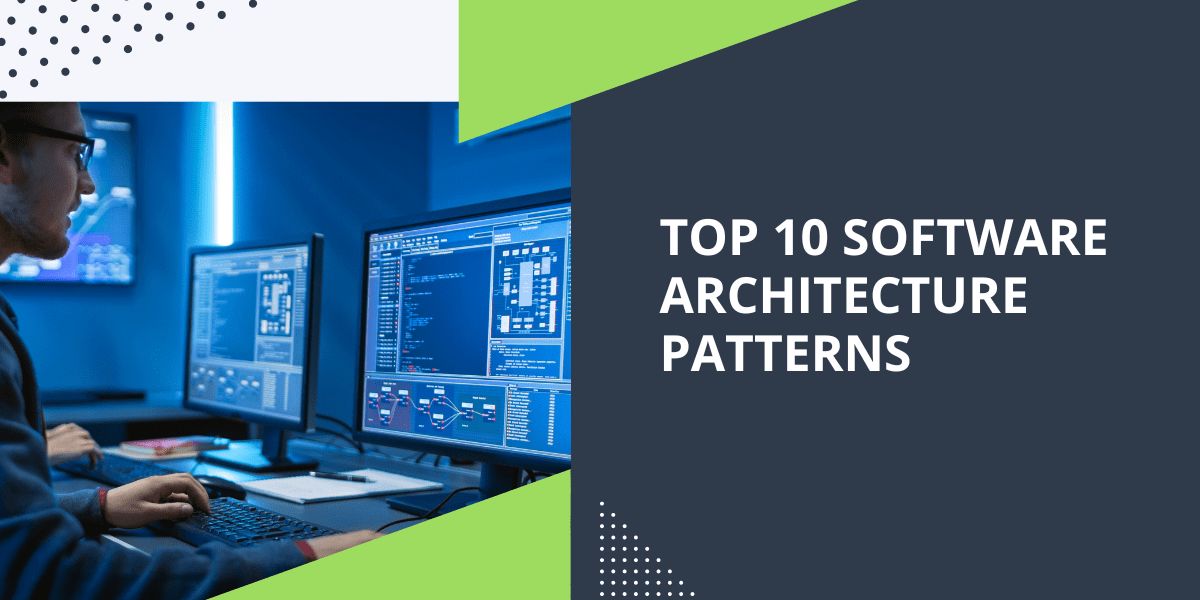The software industry has overgrown, with software development being a $100 billion industry. Most of the software created is created using software architecture patterns that combine software and hardware characteristics. The software architecture patterns are the plan to design and manage thousands of software applications.
This blog will discuss the 10 best software architectural patterns in 2023.
What Is A Software Architectural Pattern?

A software architectural pattern is a fundamental structure that includes the individual components of the whole software, especially in microservices architecture. It defines the basic principle and composition for the interaction between various microservices. The microservices architecture patterns are reusable, and software engineers can use these patterns to solve many problems in microservices-based applications.
Developers often face similar problems many times in the same microservices project. So, these architecture patterns will help resolve the issues quickly without wasting time and effort. The microservices architecture patterns such as service discovery, API gateway, circuit breaker, and event-driven architecture are commonly used to design and implement microservices-based applications. These patterns ensure the scalability, fault-tolerance, and maintainability of microservices-based applications.
Why Do We Need Software Architecture Patterns?

Functionalities
The main advantage of software architectures is that they assist in defining the fundamental characteristics, structure, advantages, and disadvantages of an application. For example, architects can employ some for scalable apps and others for agile applications.
Agile Development
The software requires many changes and modifications during the development process. If the software is developed, ped on a predefined structure and pattern, it is easy to implement these changes quickly.
If new developers join the team in the middle of the offshore software development process, it is easier for them to understand the process and make their contributions.
Hold On To Quality
Since the software architecture patterns are reusable, developers can use them as standard patterns to create the products. When the fundamental structure is predefined, it gives software engineers an idea- of how the software should look like. Thus, it reduces the chances of errors and helps deliver standard quality software consistently.
Boost Productivity
Another direct benefit of the software architecture patterns is time efficiency and enhanced productivity. When the architecture is defined, the entire nearshore software development process becomes crystal clear and thus helps in developing applications faster.
Top 10 Software Architecture Patterns

Layered Architecture Pattern
Layered architecture is popularly called multi-layered, tiered, or n-tier architecture. Designers and software engineers prefer this pattern for its tiered method, where one layer offers services to another. Developers use this pattern to interconnect all the components without dependency on each other. The layered architecture is divided into four layers: presentation, business, persistence, and database.
Event-Driven Architecture Pattern
The next in our list of the best software architecture patterns is the Event-driven Architecture Pattern. Under this type of application software pattern, data is delegated to multiple modules. Each module has a specific data type that helps in managing development efforts.
The event-driven architecture differs from an N-tiered architecture, where data flows through every tier. Under this pattern, modules interact only with the tagged events and not all. The pattern is scalable and easily adaptable; thus, enterprises prefer this pattern.
The example of an event can be when a user registers for an application,. say Instagram. When the user enters the name and mailID, the account is created. It is called an event.
Example: Event-driven architecture pattern is useful to develop an eCommerce website.
Microkernel Architecture Pattern
The Microkernel architecture pattern consists of a core system and multiple plugin modules. The plugin modules are autonomous components that support specialized processing, whereas the core system requires minimal functionality to keep the system running.
The core system is designed to perform the core functionalities with no custom code for unique or special procedures. On the other hand, the plugin modules are designed to improve the primary system to produce more commercial capabilities.
For example, the microkernel manages all the scheduling and trigger logic in a task scheduler, while the plugins manage the individual jobs.
Example: Microkernel pattern is ideal for Product-based applications and scheduling applications. For example, Instagram reels and YouTube Shorts.
Space-Based Architecture Pattern
Space-Based Architecture Pattern is next on our list of the most popular software architecture patterns. The ability of the space-based design pattern to handle serious loading issues sets it apart from the competition.
Nowadays, most applications need a database to handle and manage heavy traffic and user data requests. But when the database fails to support this heavy traffic load, the website crashes.
When a database cannot support the load, most patterns that deal with databases typically result in app failures. On the other hand, this specific pattern introduces the idea of tuple space or distributed shared memory.
Client-Server Architecture Pattern
As the name suggests, this architecture has two main components – a client and a server. The communication between the client and server, which may or may not be connected to the same network, is more accessible with this architecture.
For example, a client can request the server to gather data or resources such as files, services, content, etc. Once the client makes a request, the server identifies it and responds with the required resources.
The client-server architecture is flexible, where servers are classified according to the available resources. A single server can serve multiple clients in or out of the network, or a client can use many servers.
Example: An example of this architecture can be the Email app.When a user searches for a particular email, it sends a request to the server. The server then locates the email and sends it back to the client. Other examples can be a file sharing app or a banking app.
Master-Slave Architecture Pattern
A master-slave architecture is based on a structure where a master database creates many slave components to process user requests quickly.
In other words, the master database assigns tasks to multiple slave components. Once the task finishes, the slave components send them back to the master architecture that compiles all the tasks. After compilation, the master database sends the result to clients.
The significant advantage of this software architecture is that it helps rapidly process requests. Since all the slave components work together, they generate results simultaneously, speeding up the process. Once all the enslaved people send their results, then only the task completes.
Example: An example of such architecture can be a database application that requires handling multiple requests at the same time.
Pipe-Filter Pattern
In the pipe-filter architecture pattern, the components are called filters, and the data flows into these filters through pipes that connect these filters. There is no direction for the flow of data under this pattern. In the place where the pipes transmit the data, the processing takes place in that filter. After one filter processes the data, it transmits the result to the next filter. Then, the following filter further processes the data and transmits the result to the next, and the process goes on.
The primary purpose of this architecture is to break down complex processes into smaller components to process them simultaneously by different filters.
Example: An example of the Pipe-filter architecture pattern can be a web application.
Broker Architecture Pattern
The broker pattern consists of three major components- a client, a server, and a broker. The broker is responsible for coordinating communication among different components. The pattern is used to structure and organize the decoupled components. The broker has access to all the services of a particular server. Thus, when a client requests a service, the broker forwards that request to a relevant server.
The broker architecture pattern manages and separates all the communication-related code into layers. Further, it manages operations like change, addition, deletion, and more.
Example: An example of a Broker architecture pattern is CORBA and web services.
Peer-To-Peer Architecture Pattern
Under the peer-to-peer architectural pattern, each component is called a peer. Every component can play any role and also change its role dynamically. When a peer requests a service, it is a client, while the other peer processing the request is called a server.
Example: An example of a peer-to-peer architecture pattern is a file-sharing network like Skype or BitTorrent. Skype uses the VoIP P2P architecture pattern to send messages or make voice calls.
| Architecture Pattern | Agility | Ease Of Deployment | Testability | Scalability | Performance | Ease of Development |
|---|---|---|---|---|---|---|
| Layered Pattern | Hard to Make changes | Redeployment is required even for minor changes. | Presentation components can be mocked. | Hard To Scale | Not suitable for high-performance apps. | Easy to develop |
| Event-Driven Pattern | Possible to make isolated changes with no dependency on other components | Decoupled nature makes it easy to deploy | Specific testing tools are required to generate events. | Very easy to scale | Apt for high-performance apps | Complex development |
| Microkernel Pattern | Easier to make changes with loosely coupled components | Plugin modules make it easy | Possible to test Plugin modules separately, and they can be mocked. | Hard to Scale | Easy to customize & streamline apps (High) | Hard to develop (Low) |
| MicroServices Pattern | Easy with loosely coupled Patterns | Deployed as separate units | Isolation of apps makes it easy | Highly scalable | Slow due to distributed nature of patterns | Development easy with smaller & isolated components |
| Space-based Pattern | Easy due to smaller size | Easy deployment with cloud-based tools | It is expensive & time-consuming | Highly scalable | Faster with caching mechanism & in-memory data access | Complex due to caching and in-memory data grid |
| Client-Server Pattern | Hard to change larger apps | Cost-effective | Easy to test | Highly scalable | Constant performance | Easy to develop |
| Master-Slave Pattern | Hard to partition | Easy due to slave components | Parallel testing makes easy | Highly scalable | Smoother performance due to division of task | Easy due to multiple smaller components |
| Pipe-Filter Pattern | Parallel processing speeds up the process | Can be deployed separately | Can be tested in isolation | Scalable | Slow performance due to additional filters in the pipeline | Easy to develop due to prototyping |
Do I Need To Hire A Software Architect?

A software architecture pattern gives a fundamental pattern or vision based on a company’s long-term goals. Hiring a software architect with experience and expertise in picking the best architectural approaches will surely benefit a business.
A senior software architect can guide and train lead engineers in choosing the correct architecture pattern. He can discover the talent gaps and can help fill those gaps with practical training and guidance.
As a top custom software development company in India, Echoinnovate IT holds an array of certified software engineers with over a decade of experience in software development and deployment.
Have expert engineers with excellent knowledge and experience in adopting the best architectural approaches for software projects. Our consultations have facilitated businesses in adopting exemplary architecture for their software application. You can hire dedicated software developers from Echoinnovate IT at flexible models and costs.
Conclusion
It can be challenging to pick a software architecture pattern that will work for your company but finding one that works well is worth all the effort.
Our list of the ten best software architecture patterns will help you choose the apt one. If you need expert support to pick the correct software architecture pattern for your project, connect us at Info@echoinnovateit.com
FAQs
What is the difference between a software architecture pattern and a design pattern?
Both have a fragile line of difference, creating confusion. A software architecture pattern defines the fundamental characteristics and components of an application. The design pattern defines the app’s appearance and looks with all its elements.
Why is the Software Architecture pattern important?
A software architecture pattern is crucial as it defines a software’s fundamental structure and characteristics. When the primary characteristic and purpose of the software are defined, the software development process becomes agile, boosting productivity. In addition, it is easier to solve problems and maintain quality consistently.
Which software architecture pattern is suitable for building apps like Netflix, and why?
The choice of a tech stack for a FinTech startup in 2023 depends on the specific requirements and goals of the company. Each fintech startup idea should careMicroservices architecture pattern is relevant to develop applications like Netflix. Each website component is independent in this pattern and acts as a separate piece of software. Thus, it is easier to operate and manage different elements of the entire application, and it can respond quickly to users’ requests. fully evaluate its needs and choose a tech stack that aligns with its business model and target audience.



